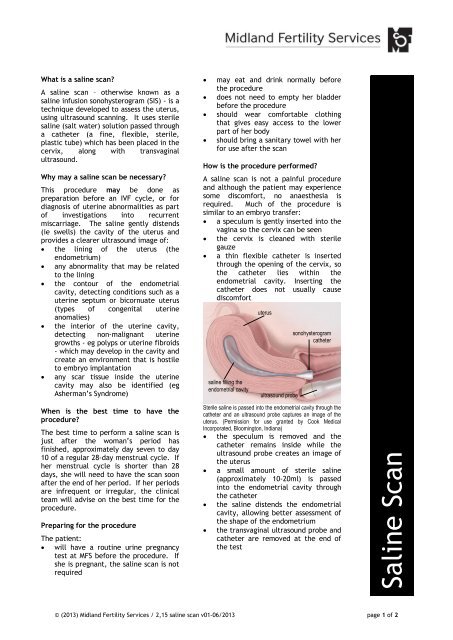Saline Scan - Midland Fertility Services
Saline Scan - Midland Fertility Services
Saline Scan - Midland Fertility Services
Create successful ePaper yourself
Turn your PDF publications into a flip-book with our unique Google optimized e-Paper software.
<strong>Saline</strong> <strong>Scan</strong><br />
What is a saline scan?<br />
A saline scan – otherwise known as a<br />
saline infusion sonohysterogram (SIS) - is a<br />
technique developed to assess the uterus,<br />
using ultrasound scanning. It uses sterile<br />
saline (salt water) solution passed through<br />
a catheter (a fine, flexible, sterile,<br />
plastic tube) which has been placed in the<br />
cervix, along with transvaginal<br />
ultrasound.<br />
Why may a saline scan be necessary?<br />
This procedure may be done as<br />
preparation before an IVF cycle, or for<br />
diagnosis of uterine abnormalities as part<br />
of investigations into recurrent<br />
miscarriage. The saline gently distends<br />
(ie swells) the cavity of the uterus and<br />
provides a clearer ultrasound image of:<br />
the lining of the uterus (the<br />
endometrium)<br />
<br />
any abnormality that may be related<br />
to the lining<br />
the contour of the endometrial<br />
cavity, detecting conditions such as a<br />
uterine septum or bicornuate uterus<br />
(types of congenital uterine<br />
anomalies)<br />
<br />
<br />
the interior of the uterine cavity,<br />
detecting non-malignant uterine<br />
growths - eg polyps or uterine fibroids<br />
- which may develop in the cavity and<br />
create an environment that is hostile<br />
to embryo implantation<br />
any scar tissue inside the uterine<br />
cavity may also be identified (eg<br />
Asherman’s Syndrome)<br />
When is the best time to have the<br />
procedure?<br />
The best time to perform a saline scan is<br />
just after the woman’s period has<br />
finished, approximately day seven to day<br />
10 of a regular 28-day menstrual cycle. If<br />
her menstrual cycle is shorter than 28<br />
days, she will need to have the scan soon<br />
after the end of her period. If her periods<br />
are infrequent or irregular, the clinical<br />
team will advise on the best time for the<br />
procedure.<br />
Preparing for the procedure<br />
The patient:<br />
will have a routine urine pregnancy<br />
test at MFS before the procedure. If<br />
she is pregnant, the saline scan is not<br />
required<br />
<br />
<br />
<br />
<br />
may eat and drink normally before<br />
the procedure<br />
does not need to empty her bladder<br />
before the procedure<br />
should wear comfortable clothing<br />
that gives easy access to the lower<br />
part of her body<br />
should bring a sanitary towel with her<br />
for use after the scan<br />
How is the procedure performed?<br />
A saline scan is not a painful procedure<br />
and although the patient may experience<br />
some discomfort, no anaesthesia is<br />
required. Much of the procedure is<br />
similar to an embryo transfer:<br />
a speculum is gently inserted into the<br />
vagina so the cervix can be seen<br />
the cervix is cleaned with sterile<br />
gauze<br />
a thin flexible catheter is inserted<br />
through the opening of the cervix, so<br />
the catheter lies within the<br />
endometrial cavity. Inserting the<br />
catheter does not usually cause<br />
discomfort<br />
saline filling the<br />
endometrial cavity<br />
uterus<br />
ultrasound probe<br />
sonohysterogram<br />
catheter<br />
Sterile saline is passed into the endometrial cavity through the<br />
catheter and an ultrasound probe captures an image of the<br />
uterus. (Permission for use granted by Cook Medical<br />
Incorporated, Bloomington, Indiana)<br />
the speculum is removed and the<br />
catheter remains inside while the<br />
ultrasound probe creates an image of<br />
the uterus<br />
a small amount of sterile saline<br />
(approximately 10-20ml) is passed<br />
into the endometrial cavity through<br />
the catheter<br />
the saline distends the endometrial<br />
cavity, allowing better assessment of<br />
the shape of the endometrium<br />
the transvaginal ultrasound probe and<br />
catheter are removed at the end of<br />
the test<br />
© (2013) <strong>Midland</strong> <strong>Fertility</strong> <strong>Services</strong> / 2,15 saline scan v01-06/2013 page 1 of 2
After the procedure<br />
The patient should:<br />
wear a sanitary towel (not a tampon)<br />
be able to drive and resume normal daily<br />
activities<br />
eat and drink normally<br />
take the antibiotics prescribed by MFS (see<br />
below)<br />
What are the risks?<br />
There is a small risk that any infection within the<br />
cervix may spread to the uterine cavity during the<br />
procedure. After the procedure the patient should<br />
take the antibiotics MFS will prescribe for her, as<br />
directed, to minimise this risk. She should contact<br />
MFS immediately if she experiences any of the<br />
following symptoms within a few days of the scan:<br />
unexplained fever<br />
persistent bleeding or foul-smelling vaginal<br />
discharge<br />
increasing lower abdominal pain<br />
feeling generally unwell<br />
Costs<br />
Please refer to the current List of Charges in either<br />
the Patient Finance Information leaflet or via<br />
www.midlandfertility.com/fees.<br />
Further information<br />
Please visit www.midlandfertility.com and search for<br />
‘<strong>Saline</strong> <strong>Scan</strong>’.<br />
Is pain relief needed after the procedure?<br />
Most women experience either discomfort or mild<br />
cramping period-type discomfort during the scan. If<br />
necessary, the MFS clinical team will provide pain<br />
relief for the patient before she leaves MFS.<br />
Afterwards, if required, she may take over-thecounter<br />
painkillers, as directed on the packs, such<br />
as:<br />
paracetamol with codeine<br />
ibuprofen<br />
When are the results available?<br />
The member of the MFS clinical team who does the<br />
scan will discuss the results with the patient once<br />
the procedure is complete. They will advise on the<br />
need for any further investigations and procedures or<br />
whether fertility treatment may begin.<br />
What is included in the cost?<br />
<br />
the saline scan<br />
What is not included in the cost?<br />
<br />
any other clinical or laboratory procedures,<br />
fertility investigations, treatments or<br />
preservation services for either partner<br />
Success rates<br />
The saline scan is a diagnostic procedure, not a<br />
treatment, and so success rates are not relevant.<br />
For treatment success rates, please refer to<br />
www.midlandfertility.com/success-rates for the<br />
most recent published results.<br />
© (2013) <strong>Midland</strong> <strong>Fertility</strong> <strong>Services</strong> / 2,15 saline scan v01-06/2013 page 2 of 2






